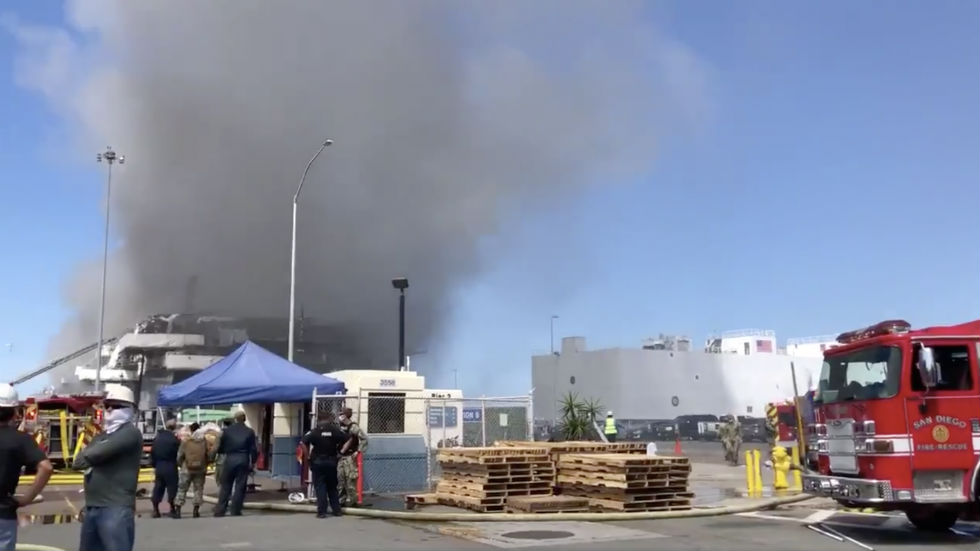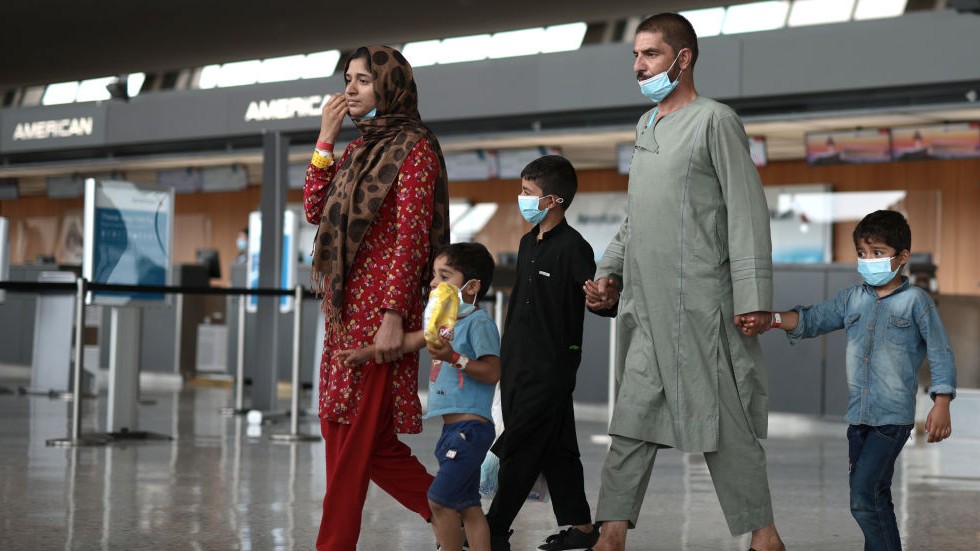Overnight Defense & National Security — Presented by Raytheon Technologies — Navy probe reveals disastrous ship fire response

It’s Wednesday, welcome to Overnight Defense & National Security, your nightly guide to the latest developments at the Pentagon, on Capitol Hill and beyond. Subscribe here: digital-stage.thehill.com/newsletter-signup.
A damning 400-page report found numerous errors and breakdowns in command when the amphibious assault ship USS Bonhomme Richard caught fire last year.
We’ll share details of the report, who is to blame for the disastrous blaze and the response from lawmakers.
For The Hill, I’m Ellen Mitchell. Write to me with tips: emitchell@digital-stage.thehill.com.
Let’s get to it.
Sailors didn’t know what to do in fire

When a fire broke out aboard the amphibious assault ship USS Bonhomme Richard in July 2020, its sailors did not know how to react and its leaders didn’t take control, a Navy investigation found.
The 400-page report, officially released on Wednesday, found that 36 individuals, including the ship’s commander and five admirals, were responsible for numerous errors and breakdowns after someone set the vessel on fire while it sat pier-side in San Diego.
“Although the fire was started by an act of arson, the ship was lost due to an inability to extinguish the fire,” the report said.
‘This is unacceptable’: Once the blaze started, “the response effort was placed in the hands of inadequately trained and drilled personnel from a disparate set of uncoordinated organizations that had not fully exercised together and were unfamiliar with basic issues to include the roles and responsibilities of the various responding entities,” the document notes.
“Overall, this command investigation concluded that the loss of the ship was clearly preventable, and this is unacceptable,” Naval Operations Vice Chief Adm. Bill Lescher told reporters on Wednesday.
Early warnings: The ship was docked at Naval Base San Diego for maintenance when the fire began on July 12 of last year. It burned for more than four days, injuring 63 people, including 40 sailors and 23 civilians, and rendering the ship unsalvageable.
The blaze was started in the Lower V space — which included such equipment as plywood pallets and CO2 bottles — but investigators found that there was confusion early on as to where it was and how to fight it.
A junior sailor, who walked through the ship following her watch around 8:10 a.m., noticed a “hazy, white fog” but didn’t report it “because she did not smell smoke.”
A breakdown: But once several others noticed the smoke shortly thereafter, communication faltered and no one established command and control of the situation.
Two firefighting teams eventually attempted to find a usable fire hose, but many were missing or cut and had not been repaired through routine maintenance.
Flame retardant was finally used nearly an hour into the blaze, but the team had to retreat after a few minutes and was not replaced.
Making matters worse, firefighters didn’t pour water onto the fire until two hours after it began, and for the first three hours the ship’s senior officers did not try to integrate civilian firefighters with its crews.
Who is to blame?: The Navy in July brought charges against Seaman Apprentice Ryan Sawyer Mays for his part in the fire.
But the investigation also found that Bonhomme Richard Capt. Gregory Thoroman, “created an environment of poor training, maintenance, and operational standards that led directly to the loss of the ship,” while the second-in-command, Capt. Michael Ray, was also responsible as he was meant to maintain crew readiness through drills and exercises.
It was also found that the ship’s sailors were woefully lacking in their firefighting drills. The crew had failed to administer flame fighting chemicals in 14 consecutive drills prior to the blaze.
Lawmaker response: Following the report’s release, Senate Armed Services Committee ranking member Jim Inhofe (R-Okla.) called the incident a “massive failure” and said the Navy “must take immediate and comprehensive corrective actions,” to prevent another such disaster.
And Rep. Rob Wittman (R-Va.), whose district includes a major shipyard for Navy warships, called the missteps around the fire a “faceplant” for the service.
A MESSAGE FROM RAYTHEON TECHNOLOGIES
Read how to deliver quick, seamless access to intelligence from any system in the battlefield, and how to adapt commercial data networks and clouds to military settings.
Almost half of Afghan evacuees at US bases are children

Almost half of the Afghans evacuated and brought to the U.S. by the military are children, according to data from the Pentagon provided to Senate Armed Services Committee Ranking Member James Inhofe (R-Okla.).
A largely classified letter shares few new details about the 53,000 Afghans brought to the U.S. during the chaotic evacuation. They are now being housed at various military bases across the country.
The breakdown: The letter shows that roughly half of those flown out by the U.S. were children, while adult men comprised 34 percent of those evacuated and adult women 22 percent.
“Of the population evacuated … 85 percent included Afghans eligible for a SIV, P1, or P2 refugee status and their family members,” Defense Secretary Lloyd Austin wrote in the letter.
What’s missing: Defense Department declined to provide a detailed breakdown of the status of the Afghans brought into the U.S., failing to reveal how many who received special immigrant visas after assisting the U.S. military were allowed to enter the country. Many who were evacuated were “paroled” into the U.S., temporarily waiving U.S. immigration laws to allow them to apply for the Priority 1 and Priority 2 programs for other vulnerable Afghans that have yet to be fully established.
The letter offers no details about those evacuated who have yet to arrive in the U.S. and was first reported by The Wall Street Journal.
Walter Reed locked down after bomb threat

The Navy base that houses Walter Reed Hospital in Bethesda, Md., was under lockdown after a bomb threat was called in by an anonymous source on Wednesday.
Naval Support Activity Bethesda base’s Twitter account announced Wednesday morning there was a bomb and shooter threat and that all personnel should get to the nearest building to undergo lockdown.
The bomb threat came from an anonymous source who called the facility.
All clear: By early afternoon the base’s commanding officer lifted the shelter-in-place order for all locations effective immediately, and by 2:45 p.m. all gates returned to normal operations.
Canceled: Walter Reed Hospital, where presidents and military personnel are treated, canceled the day’s appointments due to the lockdown.
A MESSAGE FROM RAYTHEON TECHNOLOGIES
Read how to deliver quick, seamless access to intelligence from any system in the battlefield, and how to adapt commercial data networks and clouds to military settings.
ON TAP FOR TOMORROW
- The International Institute for Strategic Studies will hold a virtual discussion on “Future U.S. Defense Strategy in East Asia,” with former Deputy Assistant Defense Secretary for Strategy and Force Development Elbridge Colby, at 8 a.m.
- Defense Secretary Lloyd Austin will attend the in-person meeting of NATO Ministers of Defense in Brussels, Belgium at 9 a.m.
- A House Appropriations subcommittee will hold a hearing on “Update on VA’s Electronic Health Record Modernization Implementation,” at 10 a.m.
- A House Natural Resources subpanel will hold a hearing on “Runit Dome and the U.S Nuclear Legacy in the Marshall Islands,” at 10 a.m.
- A House Homeland Security subcommittee will hold a hearing on “Operation Allies Welcome: Examining DHS’s Efforts to Resettle Vulnerable Afghans,” at 2 p.m.
- Ploughshares Fund will host House Speaker Nancy Pelosi (D-Calif.), House Armed Services Committee Chairman Adam Smith (D-Wash.), Rep. Ro Khanna (D-Calif.), and Principal Deputy National Security Advisor Jon Finer to discuss “Nuclear Policy in the Biden Administration and Beyond,” at 2 p.m.
- The Center for Strategic and International Studies will host a conversation on the recent nuclear submarine deal between Australia, the United Kingdom, and the United States, at 3 p.m.
WHAT WE’RE READING
- Army reservist with ‘Hitler mustache’ demoted, discharged after Jan. 6 charges: report
- Trump Defense chief blocked idea to send 250,000 troops to border: report
- Lawmaker asks Pentagon watchdog to examine military probe into paratrooper’s killing
- Russian fighters escort US bombers over Black Sea
- No American casualties reported after blast at US outpost in Syria
- Biden pick for China envoy raises concern over nuclear buildup
- Taliban promise cash, land to families of suicide bombers who attacked US and Afghan soldiers
- The Hill: Opinion: Colin Powell: Soldier, scholar, statesman and gentleman
- The Hill: Opinion: The CIA’s next mission: Strategic competition with China and Russia
That’s it for today. Check out The Hill’s defense and national security pages for the latest coverage. See you Thursday.
Copyright 2023 Nexstar Media Inc. All rights reserved. This material may not be published, broadcast, rewritten, or redistributed. Regular the hill posts








